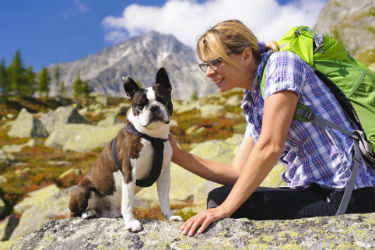Veterinarian Tips: Hiking with a Pet

It’s summer! Before clients put on their hiking shoes and set off on the trails with their best furry friend, advise them to take a moment to make sure they travel the right trails and have their pet equipped and ready to go!
Get Checked by the Vet Before Hiking
Emphasize to your clients that they should make sure the dog is ready for the type of hiking and trail being planned. Not only should you check on the animal’s basic health, you should assess the animal regarding:
- Physical fitness
- Vaccinations
- Flea and tick preventives
Advise Your Clients that Location Matters
When your clients are picking a place to hike, they must make sure it is pet friendly. Remind them to check the hiking terrain for the following:
- Find out how the trails are managed and maintained
- Look for places that will be comfortable and safe for the dog’s paws, for instance:
- Shaded trails that will be cool and won’t burn their pads
- Ground that is soft or covered with pine needles and leaves that will keep from cutting pads
- Avoid:
- Trails dedicated for use by people with horses or mountain bikes
- Going off-path. While these trails may seem more interesting or adventurous, they may be less safe or become more difficult for your pet to maneuver. Advise clients to steer clear of:
- Paths that are not routinely maintained
- Unmarked trails
- Areas with sloping sides and steep drops
- Trails that have eroded
- Areas with heavy debris, such as downed trees
Do You Offer Dog Gear for Hiking?
When hiking, every person and every dog can be responsible for the items they need. Do you offer dog packs and harnesses in a variety of sizes. When fit correctly, dog packs provide a convenient way to carry a load on the trail. Advise clients to adjust the harness to fit snugly by placing fingers under the harness. Measure to fit 2 fingers vertically between the harness and dog’s skin
Clients can load the saddlebags or pockets with:
- Treats
- Dog food
- Water
- Bowls
- Blanket
- Cooling collar
- Extra collar and leash
- Emergency contact information sealed in a plastic bag
Remind your clients that, after loading, they should recheck the pack for:
- Equal weight on both sides
- Slipping
- Weight, which should total less than a third of the animal’s body weight.
Clients should also doublecheck the dog’s collar and leash to look for:
- Strength of buckle
- Properly secured rabies tag, license tag, and owner contact information
- Strong attachment rings on both leash and collar
Do Your Clients Know Trail Etiquette?
- Keep pet leashed
- Yield the trail to others by stepping off the trail to the right
- When yielding, keep dog calm
- Plan to either carry dog poop back out of the camp or follow the regulations and bury it in an appropriately designated area. All dog owners should carry bags.
Are Your Clients Aware of Water Problems?
Advise clients about the risk of Giardia, which can be acquired by drinking trail water that comes from contaminated streams and lakes.
- Protozoan disease
- Acute or chronic, intermittent or persistent diarrhea
- Humans and animals affected
Suggest to your clients that they carry water or have on hand the means to filter trail water.
The general rule of thumb for a dog’s water needs:
- Dogs less than 20 pounds will need 1.5 ounces of water per pound of dog each day
- Dogs over 20 pounds may require up to 1 ounce of water per pound each day
How Will You Advise Your Clients about Pet Food to Carry While Hiking?
Deciding upon the amount of food to carry depends on factors such as:
- Time spent on the trail
- Animal’s fitness
- Difficulty of hike
The general rule of thumb is considered to be 1 cup of food per 20 pounds of dog per day.
Have You Considered Offering First Aid Supplies for Pets?
Does your practice offer pet owners first aid supplies? Every pet owner should own a first aid kit, but it’s especially important when clients are hiking with their dogs. A supply kit may include:
- Bandages
- Antiseptic
- Liquid bandage
- Tweezers
- Syringe for irrigation
- Forceps or tweezers for thorn and/or tick removal
Overnight or Extended Camping and Hiking Tips
For safety, advise clients to bring the dog into the tent with them at night, but before they enter:
- Towel the dog dry
- Check them over carefully for stowaways they may have picked up, such as insects, thorns, and burs
When talking to clients, if backpacking and hiking is a new idea, suggest that they ease into hiking. Starting with hikes of a shorter length and time and then gradually working into the longer trails may increase the chance that the future of hiking with their pet will be one that is looked forward to!
If many of your clients hike or backpack with their pets, consider offering related gear, such as harnesses, backpacks and first aid kits.
Sources:
https://www.backpacker.com/skills/the-manual-take-your-dog-hikinghttps://www.rei.com/learn/expert-advice/hiking-dogs.html
https://www.amazon.com/dog-packs/b?ie=UTF8&node=3400531
https://northamerica.covetrus.com/resource-center/blogs/animal-health/animal-health/2017/05/31/safety-tips-for-taking-a-pup-to-the-dog-park
Careers
Are you looking for a place to let your talents shine? At Covetrus, we help our practitioner customers better serve their patients and take pride in providing the best customer experience possible. Search our open positions to see our available opportunities.
Newsletter
Stay current with what’s going on with Covetrus, subscribe to receive our newsletter and email communications. Subscribers will receive the latest information in practice management, sales and marketing, animal health, and more.


Leave a comment